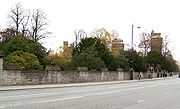
Animal Wall
Encyclopedia

Castle Quarter
Castle Quarter is a commercial area in the north of the city centre of Cardiff, Wales.The Castle Quarter includes some of Cardiff's Victorian and Edwardian arcades: Castle Arcade, High Street Arcade and Duke Street Arcade, and principal shopping streets: St Mary Street, High Street, Castle Street...
of the city centre
Cardiff city centre
Cardiff city centre is the central business district of Cardiff, Wales. The area is tightly bounded by the River Taff to the west, the Civic centre to the north and railway lines and two railway stations - Central and Queen Street - to the south and east respectively...
of Cardiff
Cardiff
Cardiff is the capital, largest city and most populous county of Wales and the 10th largest city in the United Kingdom. The city is Wales' chief commercial centre, the base for most national cultural and sporting institutions, the Welsh national media, and the seat of the National Assembly for...
, Wales
Wales
Wales is a country that is part of the United Kingdom and the island of Great Britain, bordered by England to its east and the Atlantic Ocean and Irish Sea to its west. It has a population of three million, and a total area of 20,779 km²...
. It is a Grade I listed structure.
History

William Burges (architect)
William Burges was an English architect and designer. Amongst the greatest of the Victorian art-architects, Burges sought in his work an escape from 19th century industrialisation and a return to the values, architectural and social, of an imagined mediaeval England...
in 1866, but it was not built until 1890, after Burges's death in 1881. The work of the restoration of Cardiff Castle
Cardiff Castle
Cardiff Castle is a medieval castle and Victorian architecture Gothic revival mansion, transformed from a Norman keep erected over a Roman fort in the Castle Quarter of Cardiff, the capital of Wales. The Castle is a Grade I Listed Building.-The Roman fort:...
and the building of the Animal Wall for the Marquess of Bute
John Crichton-Stuart, 3rd Marquess of Bute
John Patrick Crichton-Stuart, 3rd Marquess of Bute KT, KSG, KGCHS was a landed aristocrat, industrial magnate, antiquarian, scholar, philanthropist and architectural patron.-Early life:...
, was continued by his former assistant William Frame. The original nine animal figures were sculptured by Thomas Nicholls, they were the hyena, wolf, apes, seal, bear, lioness, lynx, and 2 different lions. They were painted in naturalistic colours, although since then the paint work on the sculptures has been removed.
The wall was moved about 50 metres (164 ft) from outside Cardiff Castle to its present location outside Bute Park
Bute Park
Bute Park in Cardiff, Wales, is an extensive area of mature parkland easily accessible from the city centre. Flanked by the River Taff, Sophia Gardens, Pontcanna Fields and Cardiff Castle, Bute Park is a very popular 'green lung' full of historic and wildlife interest. Few cities have such a...
in 1922, due to road widening in front of the castle in Duke Street and Castle Street (A4161
A4161 road
The A4161 is a main road in Cardiff, Wales, United Kingdom.The road links Cardiff city centre with Ely and the M4 motorway via the A48 and the A4232 to the west and Cardiff city centre with Rumney and the A48 motorway via the A4232 and the A48 to the east.- History of the road number :The original...
). In 1931 six further animals were added the pelican, ant-eater, racoons, leopard, beaver and vulture. They were sculptured by Alexander Carrick. In the 1970s Council planners had wanted to demolish the Wall to widen the road again, but this idea was later abandoned.
As part of a £5.6 million refurbishment of Bute Park
Bute Park
Bute Park in Cardiff, Wales, is an extensive area of mature parkland easily accessible from the city centre. Flanked by the River Taff, Sophia Gardens, Pontcanna Fields and Cardiff Castle, Bute Park is a very popular 'green lung' full of historic and wildlife interest. Few cities have such a...
, restoration of the animals began in July 2010. During the repair, the anteater's missing nose, which has been missing since the late 90s, was replaced as well as the missing glass eyes in the nine original animals.

